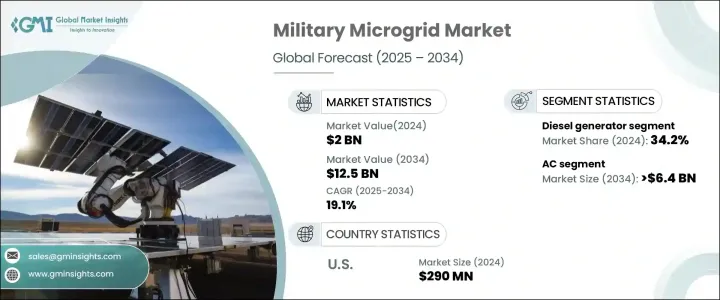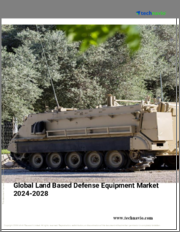
|
시장보고서
상품코드
1721549
군용 마이크로그리드 시장 기회, 성장 촉진요인, 산업 동향 분석 및 예측(2025-2034년)Military Microgrid Market Opportunity, Growth Drivers, Industry Trend Analysis, and Forecast 2025 - 2034 |
||||||
세계의 군용 마이크로그리드 시장은 2024년 20억 달러로 평가되었고 CAGR 19.1%를 나타내 2034년에는 125억 달러에 이를 것으로 추정되고 있습니다. 때로는 임무의 연속성을 확보하기 위해 탄력적이고 자율적인 전력 시스템을 적극적으로 배치하고 있습니다. 지정학적 긴장이 높아지고, 작전 지형이 복잡해짐에 따라, 군는 집중형 송전망과 독립적으로 기능하는 견고한 마이크로그리드 솔루션을 점점 요구하고 있습니다.

이러한 시스템은 중요한 인프라 취약성을 최소화할 뿐만 아니라 국내외로의 전개에 있어서의 임무 보증을 강화합니다. 소화와 에너지 효율화의 추진은 신재생에너지와 통합된 마이크로그리드의 도입을 뒷받침하고 있습니다.
| 시장 범위 | |
|---|---|
| 시작 연도 | 2024년 |
| 예측 연도 | 2025-2034년 |
| 시작 금액 | 20억 달러 |
| 예측 금액 | 125억 달러 |
| CAGR | 19.1% |
그리드 장애나 사이버 인시던트 발생 시에 중요한 군사 시스템이나 인프라를 계속 운용하기 위한 무정전 전원에 대한 요구가 높아지면서 계속 시장을 견인하고 있습니다. 전통의 송전망은 여전히 자연재해나 사이버 시큐리티의 위협, 계획외의 정전에 휩쓸리기 쉬워, 전략적인 운용이 손상될 가능성이 있습니다. 자율형의 군용 마이크로그리드는 신뢰성이 높은 상시 가동의 전력을 공급하는 것으로 이 격차를 메워, 작전
DC 마이크로그리드 분야는 2025년부터 2034년까지의 CAGR이 18.7% 이상을 나타낼 것으로 예측되어 현저한 성장을 이룰 것으로 보입니다. DC 마이크로그리드는 안정적이고 일관된 전력을 공급합니다. 전 세계 군사 시설에서는 연료 의존도를 낮추고 에너지 회복력을 높이고 전반적인 지속가능성을 향상시키기 위해 DC 기반 시스템을 채택하는 경우가 늘어나고 있습니다.
전원과 관련하여 군용 마이크로그리드 시장에는 디젤 발전기, 천연 가스, 태양열 발전, 열전병급(CHP) 시스템 등이 포함됩니다. 4.2%를 차지합니다.이 시스템은 장기간의 백업 전원 공급 장치로 신뢰할 수 있으며 특히 전원 중단이 작전을 위태롭게 할 수있는 오프 그리드와 위험이 높은 군사 지역에서 중요합니다.
미국의 군용 마이크로그리드 시장은 2024년에 2억 9,000만 달러에 이르렀습니다.
세계의 군용 마이크로그리드 시장 주요 기업으로는 ABB, FlexGen Power Systems, Siemens, Saft, General Electric, Schneider Electric, Caterpillar, Stellar Energy, PG& E, Piller Power Systems, Ameresco 등이 있습니다. 이러한 기업은 적극적으로 제품 라인을 확대하고, 기술 혁신에 투자하고, 방위 기관과 전략적 협력 관계를 맺고 있습니다. 연구 개발에 대한 지속적인 투자와 세계 비즈니스 확장은 대기업이 경쟁력을 유지하고 효율적이고 안전한 미션 크리티컬 전력 솔루션에 대한 수요 증가에 대응할 수 있도록 도와줍니다.
목차
제1장 조사 방법과 범위
제2장 주요 요약
제3장 업계 인사이트
- 업계 에코시스템
- 규제 상황
- 업계에 미치는 영향요인
- 성장 촉진요인
- 업계의 잠재적 위험 및 과제
- 성장 가능성 분석
- Porter's Five Forces 분석
- 공급기업의 협상력
- 구매자의 협상력
- 신규 참가업체의 위협
- 대체품의 위협
- PESTEL 분석
제4장 경쟁 구도
- 서론
- 전략적 대시보드
- 혁신 및 지속가능성 전망
제5장 시장 규모와 예측 : 연결성별(2021-2034년)
- 주요 동향
- 그리드 연결
- 오프 그리드
제6장 시장 규모와 예측 : 전원별(2021-2034년)
- 주요 동향
- 디젤 발전기
- 천연가스
- 태양열 발전
- CHP
- 기타
제7장 시장 규모와 예측 : 저장 장치별(2021-2034년)
- 주요 동향
- 리튬 이온
- 납축 전지
- 플로우 배터리
- 플라이휠
- 기타
제8장 시장 규모와 예측 : 그리드 유형별(2021-2034년)
- 주요 동향
- AC
- DC
- 하이브리드
제9장 시장 규모와 예측 : 지역별(2021-2034년)
- 주요 동향
- 북미
- 미국
- 캐나다
- 멕시코
- 유럽
- 독일
- 프랑스
- 영국
- 러시아
- 스페인
- 이탈리아
- 덴마크
- 아시아태평양
- 중국
- 일본
- 한국
- 인도
- 호주
- 중동 및 아프리카
- 사우디아라비아
- 아랍에미리트(UAE)
- 남아프리카
제10장 기업 프로파일
- ABB
- Ameresco
- Caterpillar
- FlexGen Power Systems
- General Electric
- Piller Power Systems
- PG&E
- Saft
- Stellar Energy
- Schneider Electric
- Siemens
The Global Military Microgrid Market was valued at USD 2 billion in 2024 and is estimated to grow at a CAGR of 19.1% to reach USD 12.5 billion by 2034. The expanding threat landscape, combined with increasing dependency on advanced technologies in military operations, is making energy security more vital than ever. Armed forces across the globe are actively deploying resilient and autonomous power systems to ensure mission continuity during outages, cyberattacks, or grid disruptions. As geopolitical tensions rise and operational terrains become more complex, military forces are increasingly seeking robust microgrid solutions that can function independently of centralized grids.

These systems not only minimize the vulnerability of critical infrastructure but also enhance mission assurance in both domestic and overseas deployments. Rising concerns about fuel supply chain vulnerabilities, especially in remote or hostile zones, are pushing military organizations to invest in scalable and cost-efficient energy solutions. Moreover, the push toward decarbonization and energy efficiency is encouraging the adoption of renewable-integrated microgrid setups. Governments and defense agencies are prioritizing energy independence through resilient infrastructure, leading to heightened demand for military microgrids that deliver uninterrupted power and operational flexibility.
| Market Scope | |
|---|---|
| Start Year | 2024 |
| Forecast Year | 2025-2034 |
| Start Value | $2 Billion |
| Forecast Value | $12.5 Billion |
| CAGR | 19.1% |
The increasing need for uninterrupted power to keep critical military systems and infrastructure operational during grid failures or cyber incidents continues to drive the market. The demand for cost-effective energy solutions in remote environments-where supply lines remain exposed to attack or disruption-is accelerating microgrid adoption. Conventional power grids are still prone to natural disasters, cybersecurity threats, and unplanned outages, which can compromise strategic operations. Autonomous military microgrids are filling that gap by delivering reliable, always-on power, significantly improving operational readiness and resilience.
The DC microgrid segment is set to witness remarkable growth, with a projected CAGR of over 18.7% from 2025 to 2034. This segment's rise is largely due to the efficiency advantages and easy integration with battery storage and renewable energy systems. By minimizing conversion losses and enabling seamless scalability, DC microgrids provide stable and consistent power-an absolute requirement for modern defense operations. Military installations around the world are increasingly adopting DC-based systems to lower fuel dependency, boost energy resilience, and improve overall sustainability.
In terms of power sources, the military microgrid market includes diesel generators, natural gas, solar PV, combined heat and power (CHP) systems, and others. In 2024, diesel generators held a 34.2% market share. These systems are highly reliable for long-duration backup power, particularly in off-grid and high-risk military areas where power disruptions could jeopardize operations.
The U.S. Military Microgrid Market reached USD 290 million in 2024. Growing concerns over energy resilience in the face of natural disasters, cyber threats, and grid shutdowns are driving the deployment of microgrids across U.S. military bases. Continued government investments, particularly from the Department of Defense, are accelerating the implementation of secure and efficient microgrid systems across critical installations.
Key players in the Global Military Microgrid Market include ABB, FlexGen Power Systems, Siemens, Saft, General Electric, Schneider Electric, Caterpillar, Stellar Energy, PG&E, Piller Power Systems, and Ameresco. These companies are actively expanding product lines, investing in innovation, and forming strategic collaborations with defense agencies. Partnerships with government entities are enabling the development of custom-built solutions tailored to military requirements. Continuous investments in R&D and global expansions are helping leading players stay competitive and address the growing demand for efficient, secure, and mission-critical power solutions.
Table of Contents
Chapter 1 Methodology & Scope
- 1.1 Research design
- 1.2 Base estimates & calculations
- 1.3 Forecast calculation
- 1.4 Primary research & validation
- 1.4.1 Primary sources
- 1.4.2 Data mining sources
- 1.5 Market definitions
Chapter 2 Executive Summary
- 2.1 Industry synopsis, 2021 - 2034
Chapter 3 Industry Insights
- 3.1 Industry ecosystem
- 3.2 Regulatory landscape
- 3.3 Industry impact forces
- 3.3.1 Growth drivers
- 3.3.2 Industry pitfalls & challenges
- 3.4 Growth potential analysis
- 3.5 Porter's analysis
- 3.5.1 Bargaining power of suppliers
- 3.5.2 Bargaining power of buyers
- 3.5.3 Threat of new entrants
- 3.5.4 Threat of substitutes
- 3.6 PESTEL analysis
Chapter 4 Competitive landscape, 2024
- 4.1 Introduction
- 4.2 Strategic dashboard
- 4.3 Innovation & sustainability landscape
Chapter 5 Market Size and Forecast, By Connectivity, 2021 - 2034 (USD Billion & MW)
- 5.1 Key trends
- 5.2 Grid connected
- 5.3 Off grid
Chapter 6 Market Size and Forecast, By Power Source, 2021 - 2034 (USD Billion & MW)
- 6.1 Key trends
- 6.2 Diesel generators
- 6.3 Natural gas
- 6.4 Solar PV
- 6.5 CHP
- 6.6 Others
Chapter 7 Market Size and Forecast, By Storage Device, 2021 - 2034 (USD Billion & MW)
- 7.1 Key trends
- 7.2 Lithium-ion
- 7.3 Lead acid
- 7.4 Flow battery
- 7.5 Flywheels
- 7.6 Others
Chapter 8 Market Size and Forecast, By Grid Type, 2021 - 2034 (USD Billion & MW)
- 8.1 Key trends
- 8.2 AC
- 8.3 DC
- 8.4 Hybrid
Chapter 9 Market Size and Forecast, By Region, 2021 - 2034 (USD Billion & MW)
- 9.1 Key trends
- 9.2 North America
- 9.2.1 U.S.
- 9.2.2 Canada
- 9.2.3 Mexico
- 9.3 Europe
- 9.3.1 Germany
- 9.3.2 France
- 9.3.3 UK
- 9.3.4 Russia
- 9.3.5 Spain
- 9.3.6 Italy
- 9.3.7 Denmark
- 9.4 Asia Pacific
- 9.4.1 China
- 9.4.2 Japan
- 9.4.3 South Korea
- 9.4.4 India
- 9.4.5 Australia
- 9.5 Middle East and Africa
- 9.5.1 Saudi Arabia
- 9.5.2 UAE
- 9.5.3 South Africa
Chapter 10 Company Profiles
- 10.1 ABB
- 10.2 Ameresco
- 10.3 Caterpillar
- 10.4 FlexGen Power Systems
- 10.5 General Electric
- 10.6 Piller Power Systems
- 10.7 PG&E
- 10.8 Saft
- 10.9 Stellar Energy
- 10.10 Schneider Electric
- 10.11 Siemens













